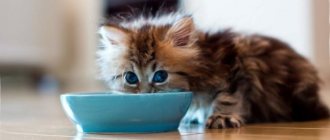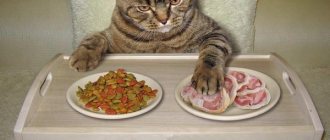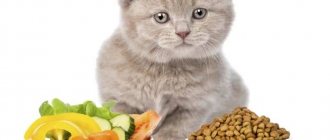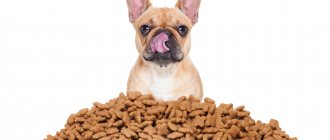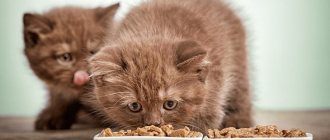What does a Scotsman look like?
“Scots” at 3 months are large babies. Average weight of kittens:
- Boys: 1.5-2.5 kg.
- Girls: 1-1.5 kg.
The weight of a small animal depends on a whole set of factors: genetic predisposition, quality of nutrition and maintenance, the speed of development of an individual kitten. Breeders recommend looking at the baby’s parents – in most cases, the offspring “copies” them. You should not expect giant kittens from medium-sized Scottish cats.
3 months is an excellent age for selling an animal, not only because it becomes independent from its mother. This is the period when all the key advantages of the future respectable “Scot” or “Scot” are visible:
- Fold-eared representatives have ears that completely fall off. Professionals can already predict the “quality” of the ears in adulthood of a representative of the breed.
- Clearly defined color. At 4-5 months, baby molting begins - the color can no longer be seen so clearly.
- The characteristics of the breed are visible. In older adolescence, kittens, like other teenagers, stretch out disproportionately - they look like “ugly ducklings”.
What to feed a 3 month old kitten: foods for a balanced diet
Since all cellular structures of the body are built on the basis of protein, meat becomes the main dish of the kitten menu, consisting of natural products. This dish takes up up to 80% of the daily diet. At the same time, it is allowed to feed the kitten only fillet of lean meats - turkey, chicken, rabbit, beef, veal.
The meat must be boiled and chopped: into small pieces or twisted into minced meat. In raw form, kittens can only be offered a frozen, high-quality product that is guaranteed to be free of helminths. Meat by-products, in particular liver, which is beneficial for the body, are allowed to be included in the menu no more than once every 7-14 days.
Vegetables and fruits. They contain many vitamins, minerals and trace elements that are essential for a growing body. Kittens, like children, need to eat them. Pumpkin, zucchini, cabbage (white and cauliflower), cucumbers, beets, carrots, apples, watermelons, greens - all this is recommended to be offered to kittens raw (grated) and boiled. If the baby refuses to eat, vegetables are mixed with minced meat or porridge is cooked in vegetable broth.
By the way, porridge should also be present in the diet of a 3-month-old kitten. The purr's digestive system responds best to oatmeal, semolina and rice. They are cooked in both vegetable and meat (low-fat) broth, milk, and water. To improve the taste, porridge is mixed with meat or vegetables in a 1:2 ratio.
Eggs are a healthy and necessary product. But not protein. Kittens are only allowed to be given boiled, crushed yolk. Raw yolk can be added to food no more than once every 7 days. Kittens are given whole quail eggs, without separating the white from the yolk, 1 piece 2-3 times a week.
Fermented milk products with the lowest percentage of fat content must be included in the kitten’s diet. Ryazhenka, kefir, natural yogurt, sour cream, liquid (baby) curds, cream, yogurt - a little bit of everything can be offered to the kitten warm.
Allowed food for a 3-month-old kitten includes fish. But in no case is it freshwater, which can become a source of helminth infection. Kittens are given only boneless sea fish fillets.
Furry pets need grass to replenish their vitamin reserves. This can be young nettle, scalded with boiling water and crushed, sprouted wheat, barley, oats. You can buy weed at a pet store or grow it yourself on a windowsill.
Special mineral supplements and vitamin complexes (in tablets, capsules) are the main source of many microelements and vitamins. If the kitten eats only natural food, they must be added to porridge and mixed into minced meat and fish. Brewer's yeast also belongs to this group of useful products. This product is added to kittens' food little by little.
What to feed a kitten
If the new owner does not have time to prepare a full menu for the kitten from fresh and high-quality natural products, then the best choice is to accustom the “Scot” to premium dry and liquid food. This is a balanced and high-quality food that contains everything necessary for a representative of the breed. The breeder or veterinarian will help you decide on the brand and type of product - in many nurseries the animals are fed ready-made food.
Natural nutrition requires more time, money and effort. It cannot sometimes be replaced with ready-made food, so as not to cause persistent gastrointestinal problems in the kitten. If the baby was offered food from the breeder, the transition to natural nutrition goes very smoothly. The owner must monitor how the pet’s body reacts to a new dish.
The main rules for fans of natural feeding:
- Under no circumstances should you offer your pets raw fish due to the risk of helminths and infections. You should completely discard river water, and be sure to boil sea water, remove the bones and give it only in small portions - it can cause urolithiasis.
- Chicken and beef meat is cleaned of bones and cartilage, finely chopped or minced, boiled or doused with boiling water.
- Meat and fish are served with a “side dish” of porridge – buckwheat, oatmeal, rice. The “dish” is not salted or sweetened.
- The offal must be thoroughly washed and boiled.
- Fermented milk products - only with a small percentage of fat content, always fresh.
A Scot should have free access to filtered, boiled water at room temperature. A sufficient frequency of feedings is 4-5 times a day.
Feeding mode
Usually, at the age of 3-4 months, kittens move to a new home. Separation from the mother and usual habitat leads to the development of stress. It is impossible to avoid stress, however, you need to make every effort to ensure that the change of environment does not harm the kitten’s health.
In the first days of life in a new home, it is not recommended to change the feeding regimen and type of food. Before moving to a new home, ask the breeder what he supplements the kittens with and how often the kittens receive food. Stock up on the necessary supplies for a few weeks until you are sure that the kitten is accustomed to its new home. Maintain your usual schedule, do not force your baby's attention, feed him on demand and make sure he empties his bowels and bladder.
Important! Against the backdrop of severe stress, the kitten will develop a loss of strength, which can lead to mild apathy and drowsiness. To smooth out the adaptation as much as possible, arrange resting places for the kitten in advance.
After a few weeks, as your pet adapts to its new home, you can develop a comfortable feeding routine. According to generally accepted rules, at the age of three months, kittens are fed 4–6 times, depending on individual characteristics. If the baby is stunted or is not gaining weight well, he is fed in small portions, but more often. At normal growth rates, the feeding frequency is reduced to 4 times. If the baby looks hungry between meals, he is offered a snack in the form of cottage cheese or milk.
A stable feeding regime allows you not only to teach your pet discipline, but also to monitor its health. The frequency of bowel movements directly depends on the feeding regimen. You will be able to notice constipation or other problems with the digestive tract in time if your pet does not go to the toilet on schedule.
Necessary care
When becoming the happy owner of a 3-month-old Scottish Fold (low-eared) or Scottish Straight (straight-eared), a person must consider the following:
- Quality of licking. The kitten tries hard to get its fur in perfect order, but it does not always have the perseverance to do it efficiently. If the owner helps with cleaning and combing the fur, then you should still teach him to wash the baby’s “buttocks” himself - sometimes lubricate the area under the tail with fish oil or vegetable oil.
- Upbringing. Three-month-old Scots, having just gotten used to it, begin to rush around the house “as if stung,” “attack” the owner’s legs and utter war cries. This is normal behavior for a kitten, but you need to start correcting his behavior - accustom him to a scratching post, discourage him from climbing on the kitchen table and “dining” with indoor flowers. The animal is not beaten or punished - they only scold in a stern voice, show the correct behavior (take it to a scratching post, cat grass), and ignore it for a while.
- Bathing and brushing. Three months is the ideal age to accustom a kitten to grooming and bathing procedures. His psyche is very plastic - the baby will soon get used to these unusual actions. The owner acts calmly, does not shout, speaks kindly, and rewards his efforts with “yummy treats.” It is already very difficult to accustom an adult, wayward “Scot” to such procedures.
- Vaccination. As a rule, the initial stage of the first vaccination remains on the conscience of the breeder. Then the owner brings his lucky acquisition to the veterinarian for an initial examination - the doctor prescribes an anthelmintic. After 10-14 days, the baby will be vaccinated again and a veterinary passport will be issued (if there is no document).
- Fortification. The kitten is actively developing - it does not have enough microelements from food. Therefore, the owner offers the “Scot” vitamin supplements with calcium and taurine. What remedy a particular kitten needs is determined only by a veterinarian.
What should you feed a kitten for 3 months?
First of all, it must be said that you should not give kittens food from your table. Even if these are products approved for pet consumption. Dishes for people are prepared with the addition of salt and spices, which are completely unnecessary for the body of tailed fidgets.
In addition, there are a number of foods that are prohibited in the diet of small kittens. Let's list the main ones:
1. Fatty meat (pork, lamb) and meat with bones (especially hollow ones).
2. Whole milk. This product is not digested in the cat's stomach. If you can’t do without milk, it is recommended to give your kitten goat’s milk instead of cow’s milk. It is much healthier and not as greasy.
3. Fermented milk products with high fat content.
4. Chicken egg white. The product contains the substance ativin, which blocks the action of biotin, which is extremely important for the developing body of the kitten. Egg whites can be mixed into your pet's food as a remedy for diarrhea.
5. Raw freshwater fish. Increases the risk of infection with intestinal parasites, leading to urolithiasis.
6. Spices, seasonings, sugar.
7. Any sausages and canned food for people.
8. Potatoes. The root vegetable is not digestible in any form by the kitten’s gastrointestinal tract, so this product is never introduced into the pet’s diet.
9. Corn (grains, cereals, flour), legumes (beans, soybeans, peas). Causes bloating and fermentation in the intestines.
10. Soft and hard cheeses with high fat content.
11. Baking, pasta, flour.
12. Any sweets, confectionery. Chocolate is especially harmful to kittens. It contains theobromine, a substance poisonous to cats. Chocolate can cause severe, even fatal, poisoning.
If a kitten has problems with digestion, foods that worsen its well-being are excluded from the diet. So, if you have diarrhea, you should not give your baby fermented milk products. For constipation, remove any solid food from the menu, such as rice.
Photos and videos of three-month-old kittens
Feeding rules
In order for a kitten to grow healthy and develop properly, it is necessary to adhere to certain rules regarding nutrition:
- The first step is to accustom the kitten to a feeding schedule in accordance with its age.
- Food should be slightly warm.
- The normal daily portion for kittens from three to five months is 200 grams with a balanced diet.
- The kitten must have access to clean, fresh water at all times.
- If the baby refuses to eat, it is necessary to show him to the veterinarian.
- Products of plant origin should not exceed 10% of the total food.
When introducing a new dish, you should pay attention to the condition of your furry pet. Kittens may have an allergic reaction to dry food and natural food.
